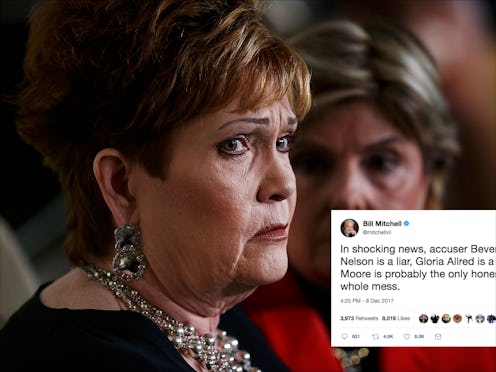News
A Roy Moore Accuser Needed A "Handwriting Expert" To Prove Her Story & It's So Gross

When Beverly Young Nelson came forward about Roy Moore allegedly forcing himself on her, she brought evidence. In her 1977 yearbook, a scribbled note: "To a sweeter more beautiful girl I could not say, 'Merry Christmas.' Love, Roy Moore." Shortly after Nelson says Moore wrote the yearbook note — which is downright creepy at best, suggestive of sexual attraction toward teenagers at worst — Moore tried to assault her in his car, she alleges. (Moore vehemently denies this.)
Yet, for Moore's supporters, the yearbook note is not "evidence." Nelson coming forward with her highly detailed story — one eerily similar to that of a handful of other women — is not "evidence." Nelson agreeing Friday that she did write the date of the yearbook note next to the justice's inscription, however, is "evidence" to Moore's supporters — evidence that Nelson has, for some inexplicable reason, been lying all along.
For the people who believe Roy Moore is no predator, the lack of verifiable "evidence" of any sexual assault at all isn't worth considering. Nothing that any survivor could do, or say, or bring forward, is likely to change their minds. (Hell, Roy Moore being allegedly banned from a mall for creeping on teenagers didn't change their minds.)
On Friday, in an interview with ABC News, Nelson said that she had made a note of the date and place underneath Moore's inscription in her yearbook. Nelson and her lawyer, Gloria Allred, brought out a handwriting expert that supported her account. This is relevant because Moore's team has claimed that the yearbook note is forged, and that handwriting analysis would reveal that Moore's handwriting is different.
If you look closely at the yearbook inscription with that detail in mind, the difference in color and handwriting does seem to suggest that two different people wrote it. In other words, Nelson hasn't tried to hide that she added her own note at the end of Moore's.
When she initially came forward with the yearbook excerpt, Nelson did not specifically say that she had written any part of it. To Moore's supporters, Nelson's admission that she added a timestamp and the date is proof that she forged the entire thing.
Here lies one issue (of many) with believing Roy Moore instead of his accusers: If you're going to pounce on one absent detail as "proof," then you must lower your burden of evidence. In other words, if this single detail means Nelson must be lying, then the many, many details indicating that Moore is a predator — the myriad women's stories; the alleged Gadsden mall banning; the neighborhood locals who confirmed that they heard rumors — means that Moore must be lying about not being one.
If you choose to believe a man is innocent until proven guilty, so be it. By that logic, however, then Nelson is telling the truth until proven otherwise. Therein lies the rub: Moore's supporters are forcing themselves to lower their standard of proof in their devotion to him, but they will not apply that same standard to a woman who questions his past actions.
This is true of Moore and Nelson specifically, but it is also achingly true of any woman who reports sexual assault. Our legal system, and, to a large extent, our society, considers men who have been accused innocent until proven guilty — but the women who accuse them are considered to be lying until proven otherwise. This is even more infuriating when you consider that there is no "evidence" for sexual assault much of the time — it frequently comes down to "he said, she said," and men are oftentimes never brought to justice.
Why were Nelson and her lawyer, Gloria Allred, forced to bring in a handwriting expert in the first place? Why was Nelson's own story — and a piece of evidence supporting that story — not sufficient? Because women have to fight harder to receive the same "justice" that men receive. Because women are so used to not being believed, they feel they must go to incredible lengths (I mean, a handwriting expert! These aren't even considered very credible!) just to convince their opponents.
And they have so many opponents — opponents that will try to find the tiniest of holes in their logic, every time, and use it to hang these women.
Nelson and Allred were not wrong to fight fire with fire, and to bring out an unbiased expert to give credence to Nelson's story. What their efforts show most starkly, however, is the frankly ridiculous lengths women are forced to go to just to be believed — while the men they accuse can face all the evidence in the world, and yet be considered the innocent party.
Editor's Note: This op-ed does not reflect the views of BDG Media and is part of a larger, feminist discourse on today's political climate.